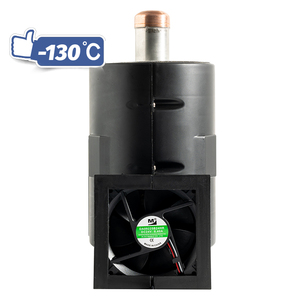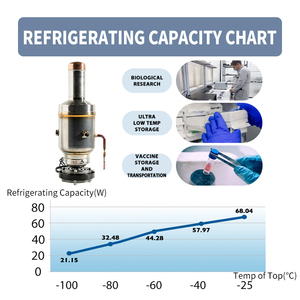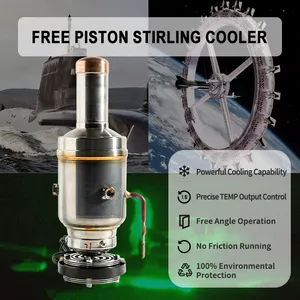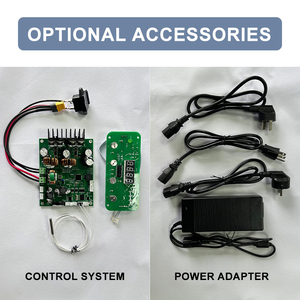
All categories
Featured selections
Trade Assurance
Buyer Central
Help Center
Get the app
Become a supplier

(1607 products available)











































A small intercooler is a heat exchange device used to cool compressed air before it enters the engine. The cooled air has a high density, and this helps to improve engine performance. Small intercoolers are ideal for small cars with small turbochargers. They are categorized based on their placement and design.
Intercooler placement
The first type is the air-to-air intercooler. This intercooler uses air flow to cool the compressed air. The small intercooler is placed after the turbocharger, and its core is surrounded by metal fins. When the car is in motion, air passes through the metal fins and cools the core. The degree of cooling depends on the ambient temperature and the intercooler's position relative to the airflow.
Water-to-liquid intercooler
Water-to-liquid small intercoolers are mostly used in racing cars. They have a higher cooling capacity than air-to-air intercoolers. The cooled air gets transferred to a reservoir filled with water. The water is then pumped through a small radiator. The radiator removes the heat from the water, which is then returned to the reservoir. The coolant in the reservoir is usually at a lower temperature than the air in the intercooler. This setup allows the water to absorb the heat from the air, which lowers the temperature of the air before it enters the engine.
Intercooler design
Bar and plate intercoolers are designed with a series of bars and plates that create channels. The compressed air and coolant flow through the channels. These intercoolers are durable and can withstand high pressure. They also have a lower pressure drop, which means they can maintain higher pressure in the intake.
Tube and fin
intercoolers have a simpler design with tubes and metal fins. The tubes are connected to the intercooler core and the metal fins, which are responsible for the heat transfer. Tube and fin intercoolers have a lower manufacturing cost and are lightweight. However, they are not very efficient and are suitable for applications where efficiency is not a top priority.
Vertical and horizontal small intercoolers
The vertical intercooler is designed to maximize the cooling effect by allowing the air to pass through the core from top to bottom. This creates a chimney effect that improves the cooling efficiency. On the other hand, horizontal intercoolers have a core that is wider than it is tall. This design maximizes the surface area of the core that is exposed to the oncoming air, resulting in better cooling.
Here are the specifications to be aware of when purchasing a small car intercooler:
Size
Small intercoolers are compact, but they still come in different sizes. The size is measured in terms of length, height, and width. A small intercooler has a length between 400 and 700 mm, a height of 200 mm, and a width of 100 mm. The dimensions affect the intercooler's performance and fit within the vehicle.
Cooling method
The small intercooler uses ambient air to cool the compressed air from the engine. The temperature drop is achieved through the heat exchange process. The temperature difference between the compressed air and the intercooler cools the compressed air.
Material
Intercoolers are made using aluminum, which is lightweight, and offers good thermal conductivity. The aluminum intercooler can quickly cool the compressed air without adding much weight.
Core design
The intercooler core is designed with parallel flow or bar and plate configurations. The cores enhance the air flow and cooling performance.
Fin
The intercooler fins are integral to heat dissipation. They are designed with louvered or offset patterns, which maximize the heat exchange surface area.
Inlet and outlet size
The intercooler inlet and outlet ports are compatible with the vehicle's intercooler piping. The inlet and outlet diameter range from 50 to 76 mm.
Pressure drop
Pressure drop is the reduction of pressure as the compressed air passes through the intercooler. For small intercoolers, the pressure drop is measured in bars and should be low, between 0.2 and 0.5 bar.
Cooling capacity
Cooling capacity refers to the intercooler's ability to cool the air. It is measured in watts or kilowatts. Small intercoolers have a cooling capacity of 2000 to 4000 watts.
Heat transfer
The heat transfer rate is the amount of heat transferred from the compressed air to the ambient air. It is measured in watts per degree Celsius. The heat transfer rate of small intercoolers is between 1000 and 2000 watts per degree Celsius.
Tuning
The intercooler is compatible with different tuning options. This is important for buyers who want to customize the intercooler for specific performance needs. The small intercooler can be used in vehicles with standard tuning or customized for high-performance vehicles.
Here are some small intercooler maintenance tips:
Buying a small intercooler is not as straightforward as it may seem. There are several factors buyers need to consider to get the right intercooler for their needs. Here are some of them:
Vehicle Specifications
Choose intercoolers that are compatible with the pipe size and mounting options of the specific vehicle. Also, consider the vehicle's engine size and tuning modifications, if any. Cars with more powerful engines need larger intercoolers.
Cooling Requirements
Determine the cooling capacity required based on the boost levels and the type of small turbo intercooler configuration supported by the vehicle. A larger intercooler offers better cooling but may affect the space available for installation.
Pressure Drop
Small intercoolers with a larger cores have a lower pressure drop. This means they will not impede airflow from the turbo to the engine. When choosing an intercooler, consider the pressure drop to avoid losing power from the engine.
Material and Construction
Choose intercoolers made from strong materials like aluminum. Aluminum is resistant to corrosion and has a high strength-to-weight ratio. This makes intercoolers last longer and minimizes the added weight to the vehicle.
Core Design
Consider the type of small intercooler core configuration and its impact on cooling efficiency. Bar and plate cores are known for their durability and are ideal for applications that require strength. However, they are heavier than tube-and-fin cores.
Space and Fitment
Find out the dimensions of the intercooler that will fit in the available space. Also, consider the location where it will be mounted. Intercoolers can be mounted in front of the car's radiator or in the space where the headlights are located.
Quality and Reliability
Buyers should get small intercoolers from reputable manufacturers to ensure that they get intercoolers with consistent performance and quality. They can also read reviews to find out what other customers have to say about the intercooler they want to buy.
Budget
Set a budget for the intercooler. The price may differ depending on the size, brand, and features of the intercooler. Additionally, consider the long-term benefits of improved performance and fuel efficiency.
Replacing and installing a new intercooler can be a DIY-friendly activity. It is easy to replace a small front mount intercooler as long as the necessary tools and intercooler kit are available. The intercooler kit has almost everything that is needed to replace an old intercooler. It comes with the intercooler itself, piping, hose clamps, and mounting hardware. The mounting hardware may include bolts and a bracket. The kit may also include a blow-off valve. The tools needed are the ones that may be required to install or remove the intercooler. They include a torque wrench, pliers, and a screwdriver. A socket set and ratchet are also needed. Below are the steps for replacing the small intercooler:
Q1: What are the benefits of having a small intercooler?
A1: A smaller intercooler can have its advantages, especially in specific contexts or applications. Here are some potential benefits: 1. Space Efficiency: A small intercooler is designed to take up less space, which can be crucial in compact vehicles or areas with limited room. 2. Weight Reduction: Smaller intercoolers can contribute to overall vehicle weight reduction, potentially improving acceleration and fuel efficiency in naturally aspirated vehicles. 3. Faster Air Recovery: In some cases, a smaller intercooler can result in quicker temperature recovery of the charged air, especially in applications with short-duration boost periods. 4. Cost Savings: Smaller intercoolers are often less expensive, both in terms of initial purchase and installation costs. 5. Reduced Pressure Drop: Intercoolers can introduce a pressure drop in the intake charge. While this is generally minimal in small intercoolers, there can be a reduced pressure drop, helping to maintain better boost pressure. 6. Tailored Applications: Smaller intercoolers can be beneficial in specific applications, such as go-karts, motorcycles, or other performance-focused vehicles where size and weight are critical.
Q2: Is it possible to install a small intercooler in a vehicle?
A2: Yes, it's entirely possible to install a small intercooler in a vehicle. In fact, intercooler installation is a common modification, especially in turbocharged or supercharged vehicles, to enhance engine performance and efficiency.
Q3: Does a small intercooler require regular maintenance?
A3: Yes, a small intercooler requires regular maintenance, like any other intercooler. While the size of the intercooler may affect the frequency or ease of maintenance, it still serves the same function as a larger one—cooling the air charge from the turbocharger before it enters the engine. Regular maintenance ensures optimal performance and longevity.
Q4: Can a small intercooler be used in high-performance applications?
A4: Yes, a small intercooler can be used in high-performance applications, particularly in vehicles designed for high performance. However, its effectiveness will depend on various factors, including the vehicle's engine size, forced induction components (like turbochargers or superchargers), and the specific requirements of the application.